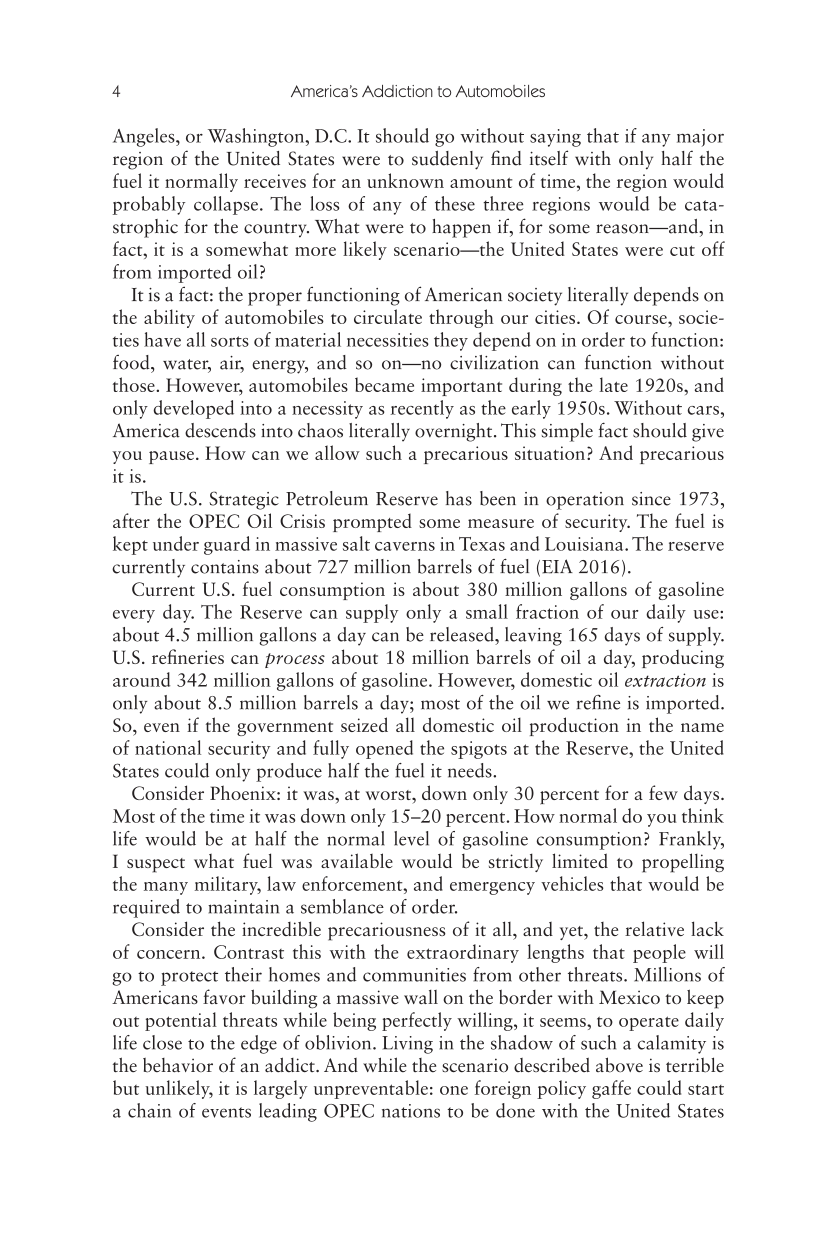4 America’s Addiction to Automobiles
Angeles, or Washington, D.C. It should go without saying that if any major
region of the United States were to suddenly find itself with only half the
fuel it normally receives for an unknown amount of time, the region would
probably collapse. The loss of any of these three regions would be cata-
strophic for the country. What were to happen if, for some reason—and, in
fact, it is a somewhat more likely scenario—the United States were cut off
from imported oil?
It is a fact: the proper functioning of American society literally depends on
the ability of automobiles to circulate through our cities. Of course, socie-
ties have all sorts of material necessities they depend on in order to function:
food, water, air, energy, and so on—no civilization can function without
those. However, automobiles became important during the late 1920s, and
only developed into a necessity as recently as the early 1950s. Without cars,
America descends into chaos literally overnight. This simple fact should give
you pause. How can we allow such a precarious situation? And precarious
it is.
The U.S. Strategic Petroleum Reserve has been in operation since 1973,
after the OPEC Oil Crisis prompted some measure of security. The fuel is
kept under guard in massive salt caverns in Texas and Louisiana. The reserve
currently contains about 727 million barrels of fuel (EIA 2016).
Current U.S. fuel consumption is about 380 million gallons of gasoline
every day. The Reserve can supply only a small fraction of our daily use:
about 4.5 million gallons a day can be released, leaving 165 days of supply.
U.S. refineries can process about 18 million barrels of oil a day, producing
around 342 million gallons of gasoline. However, domestic oil extraction is
only about 8.5 million barrels a day; most of the oil we refine is imported.
So, even if the government seized all domestic oil production in the name
of national security and fully opened the spigots at the Reserve, the United
States could only produce half the fuel it needs.
Consider Phoenix: it was, at worst, down only 30 percent for a few days.
Most of the time it was down only 15–20 percent. How normal do you think
life would be at half the normal level of gasoline consumption? Frankly,
I suspect what fuel was available would be strictly limited to propelling
the many military, law enforcement, and emergency vehicles that would be
required to maintain a semblance of order.
Consider the incredible precariousness of it all, and yet, the relative lack
of concern. Contrast this with the extraordinary lengths that people will
go to protect their homes and communities from other threats. Millions of
Americans favor building a massive wall on the border with Mexico to keep
out potential threats while being perfectly willing, it seems, to operate daily
life close to the edge of oblivion. Living in the shadow of such a calamity is
the behavior of an addict. And while the scenario described above is terrible
but unlikely, it is largely unpreventable: one foreign policy gaffe could start
a chain of events leading OPEC nations to be done with the United States






























































































































































































































































